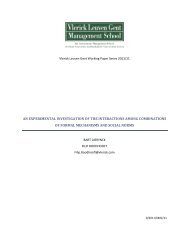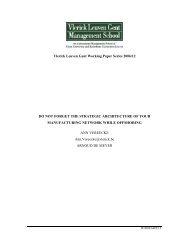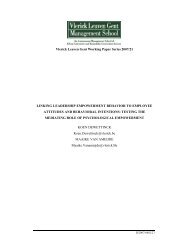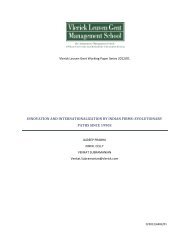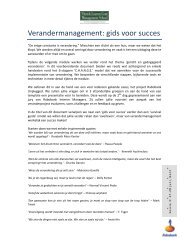Vlerick Leuven Gent Working Paper Series 2007/03 ... - Vlerick Public
Vlerick Leuven Gent Working Paper Series 2007/03 ... - Vlerick Public
Vlerick Leuven Gent Working Paper Series 2007/03 ... - Vlerick Public
Create successful ePaper yourself
Turn your PDF publications into a flip-book with our unique Google optimized e-Paper software.
By relying on their specific expertise and backgrounds they may have different<br />
viewpoints on how to accomplish these issues and especially on what trade-offs need to be<br />
made. In view of reaching a consensus, board members are deemed to challenge and critically<br />
oppose each other’s ideas. Research by Schweiger et.al (1986) suggests that the presence of<br />
debate improves group performance by formalizing and legitimizing conflict and by<br />
encouraging critical evaluation. According to Eisenhardt et.al. (1997) debate “provides a more<br />
inclusive range of information, a deeper understanding of the issues, and a richer set of<br />
possible solutions” (p.43). Simons et.al. (1999) argued that when team members are<br />
confronted with other opinions they are forced to reconsider their viewpoints with information<br />
they have not thought of before. Furthermore, team members might see the benefit of<br />
evaluating alternatives and of taking a broader approach to decision-making. Hayashi (2004),<br />
for instance, found that teams who’s members share and exchange knowledge tend to perform<br />
better. Also results of empirical research regarding the effect of task conflict on performance<br />
outcomes have proven that this type of conflict is generally beneficial. Task conflict is<br />
productive in groups performing non-routine tasks (Jehn 1995) and it enhances the quality of<br />
decisions (Amason 1996, Pelled et.al., 1999). Based on this evidence, we advance the<br />
following proposition:<br />
Proposition 6 : debate will be positively related to board task performance<br />
Limitations and boundary conditions of the model<br />
The model we have developed is characteristized by several limitations and boundary<br />
conditions. Caution is also required in empirical testing. First, the model that we propose is<br />
primarily developed for one-tier or unitary boards. Although the unitary board of directors is<br />
internationally the most prevalent, it must be noted that some European countries have a twotier<br />
board structure, for example Germany, the Netherlands and Denmark. As both systems<br />
are grounded in varying legal and historical contexts, it is clear that a unitary and a two-tier<br />
board differ substantially in their composition, operations and responsibilities. In one-tier<br />
boards, executive as well as non-executive directors convene to form one board. In such a<br />
system, executives perform a double function: as board members they are involved in board<br />
matters while as executives they are responsible for the operations and the daily execution of<br />
board decisions. In a two-tier system, the supervisory board is formed of non-executive<br />
directors only and in some cases also includes employees.<br />
23



